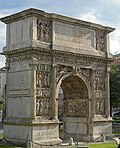Decoration
Examples of the mingling of Byzantine and Latin styles (as cited by James Hall) include:
1. The "lunette over the entrance with a half-length figure of St. Michael and above him an orant Virgin in a medallion supported by flying angels, with an inscription in Greek on the lintel at the foot. The treatment is wholly Byzantine except for the Latin motif of a crown on the Virgin's head". [2]
2. The evangelists around the enthroned Christ in the Apse are in the form of the four symbolic creatures of the Latin tradition, rather than being shown as figures (often seating at writing desks) in the Greek manner. [2]
3. Subjects from the Old Testament and New Testament line the walls of the nave. The content of individual scenes and the grouping of figures is described by Hall as being "typically Byzantine", but the whole forms an historical narrative series on the Western model, evidently just as in the basilicas of early Christian Rome. [2]
This page is based on this
Wikipedia article Text is available under the
CC BY-SA 4.0 license; additional terms may apply.
Images, videos and audio are available under their respective licenses.




